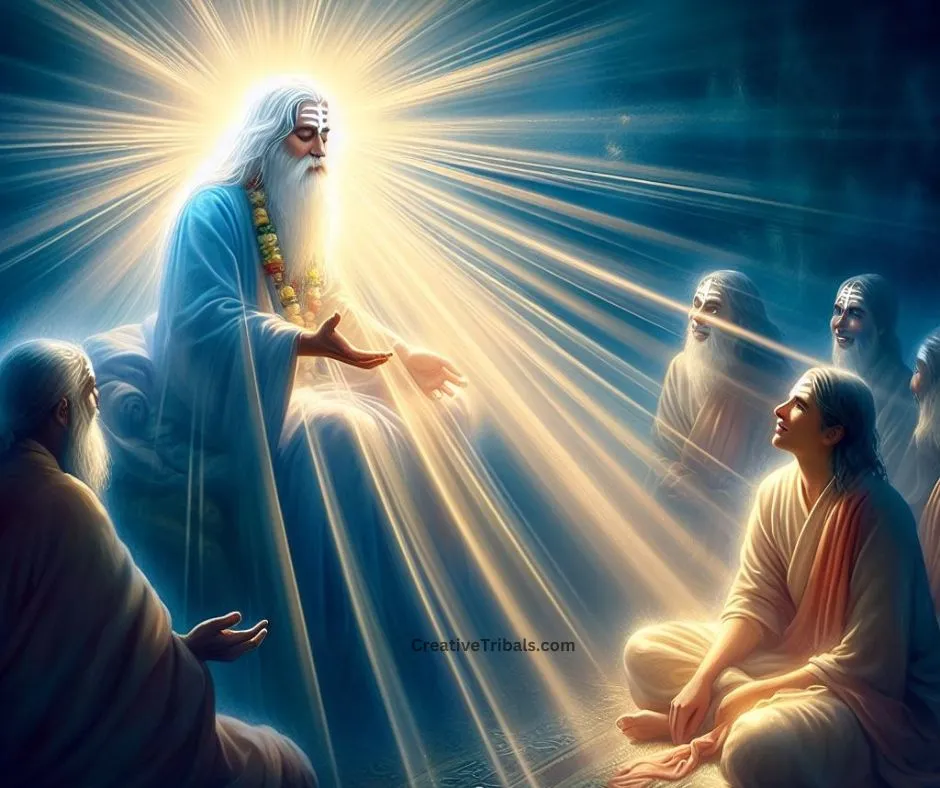Guru Purnima stands as the foremost beacon in the kaleidoscope of Indian traditions, illuminating the profound bond between teacher and student. Bathed in the ethereal glow of the full moon, this sacred day transcends mere academic pursuits, blossoming into a magnificent celebration of spiritual enlightenment.


At the Heart of the Celebration: The Guru
The essence of Guru Purnima lies in acknowledging the Guru, a figure revered beyond measure. More valuable than any worldly treasure, the Guru embodies the multifaceted role of a mentor, a friend, a parent, and a spiritual companion. They act as a guiding light, dispelling the darkness of ignorance and illuminating the path towards divine understanding.
As the celestial calendar ushers in Guru Purnima, millions of hearts resonate with a wave of gratitude and reverence. This day serves as a poignant reminder of the immense debt we owe to the enlightened souls who have dedicated their lives to nurturing knowledge and wisdom within us.
A Tapestry of Rituals and Reflection
The observance of Guru Purnima is a beautiful confluence of devotion, introspection, and celebration. Devotees gather in ashrams and humble homes alike, their minds attuned to the profound teachings of their Gurus.


The Significance of the Ashada Moon:
The full moon of Ashada holds immense significance, traditionally associated with the beginning of the monsoon season. This period is symbolically linked to reflection and learning. As revered saints establish temporary abodes, eager seekers flock to them, yearning to quench their thirst for spiritual knowledge. This confluence of teacher and student gave birth to the cherished tradition of Guru Purnima – a day dedicated to honoring the unwavering guidance of the spiritual teacher.


Touching the Divine: The Guru’s Feet
The feet of the Guru hold a position of immense reverence. Touching them signifies a profound connection to the divine, an acknowledgement of deep respect, and a commitment to traversing the path towards spiritual perfection. This act is not merely symbolic; it serves as a physical reminder of the Guru’s role in guiding us towards the ultimate realization.


An ethereal depiction of the Guru surrounded by celestial light and symbols of wisdom.
Beyond Deification: The Guru as a Vessel
While some sects elevate their Gurus to a divine status, the core essence of Guru Purnima lies in recognizing them as vessels of divine knowledge. They serve as luminous conduits, transmitting the wisdom of the ultimate reality. The Guru is not the source of knowledge itself, but rather a bridge between the seeker and the divine.
The Weight of the Guru’s Mantle
A Guru shoulders a monumental responsibility – to guide souls towards the ultimate realization of God. Their role extends far beyond mere instruction. They nurture their disciples, providing solace and support. They correct misconceptions and gently steer their students on the right path. They inspire them to delve deeper into their spiritual quests, igniting a passion for self-discovery and enlightenment.


The Mystical Communion: The Power of Darshan
The darshan, the mystical communion between Guru and student, is a deeply sought-after experience. It is believed to accelerate spiritual growth and purify the soul. In the presence of the Guru, students receive the Guru’s blessings and grace, which are said to act as a catalyst on their spiritual journey.
Offering Reverence to the Guru
Offering reverence to the Guru is a deeply ingrained practice in Hindu tradition, symbolizing the devotee’s profound respect and gratitude towards their spiritual guide. This act holds significant spiritual and symbolic importance, reflecting the disciple’s acknowledgment of the Guru’s role in their spiritual journey. Let’s delve into the various aspects of offering reverence to the Guru:


Symbolism and Historical Practices
- Feet of the Guru: In Hindu culture, the feet of the Guru are revered above all else. They symbolize a sacred connection to the divine and embody the spiritual knowledge and wisdom of the Guru. Touching the feet of the Guru is considered an act of humility and submission, acknowledging the Guru’s higher spiritual authority.
- Guru Dakshina: Offering Guru Dakshina, a token of gratitude or donation, is a traditional practice. It is not a payment for teachings but a gesture of appreciation for the invaluable spiritual guidance received. In ancient times, Guru Dakshina often consisted of offerings such as gold, food, or valuable possessions.
- Seva (Service): Serving the Guru with devotion and selflessness is another way of offering reverence. This could include performing tasks or duties for the Guru, assisting in ashram activities, or helping in community service projects. Seva is considered a path to spiritual growth and purification.
- Prayer and Mantra Recitation: Devotees often offer prayers and recite mantras in honor of their Guru. This practice fosters a deeper spiritual connection and invokes blessings from the Guru for guidance and protection on the spiritual path.
Modern Practices
- Financial Support: In contemporary times, devotees may offer financial support to the Guru’s ashram or spiritual community. This assistance helps sustain the Guru’s teachings and facilitates the upkeep of ashram facilities for the benefit of all seekers.
- Material Offerings: Devotees may offer flowers, fruits, incense, or other symbolic items at the Guru’s feet as a gesture of reverence and devotion. These offerings symbolize purity, devotion, and the beauty of spiritual offerings.
- Study and Implementation of Teachings: One of the most profound forms of reverence is to earnestly study and implement the teachings of the Guru in one’s life. By practicing the Guru’s guidance, devotees honor their Guru’s wisdom and contribute to their own spiritual evolution.
- Spread of Guru’s Teachings: Devotees may actively participate in spreading the Guru’s teachings by sharing knowledge, organizing satsangs (spiritual gatherings), or supporting initiatives that promote the Guru’s message of love, compassion, and spiritual awakening.
Sage Patanjali,
In the radiant realm of yoga, the Guru stands as a beacon of boundless energy and magnetic allure, as described by the venerable Sage Patanjali. In the Guru’s presence, a disciple is enveloped in this luminous aura, feeling uplifted and inspired. Just as a devoted practitioner of the sun’s path emits its brilliance, so too does a disciple emanate the glow and allure of their Guru. With unwavering focus on the Guru, one begins to assimilate their virtues until, over time, their very essence mirrors that of their revered teacher. Thus, the path one chooses to follow holds immense significance, for it is through emulation that transformation occurs.
Delving deeper into the etymology, the word “Guru” reveals profound symbolism. “Gu” signifies the darkness of ignorance, while “Ru” signifies its dispeller. Hence, a Guru is one who dispels the darkness of ignorance, particularly the veils of Maya, guiding seekers towards the radiant truth of God-realization. Though the term “Guru” may also extend to earthly mentors, such as schoolteachers or college lecturers, its essence lies in those who impart knowledge, be it temporal or spiritual.
In the modern era, the term “Guru” has broadened to encompass anyone who garners followers. Yet, true spiritual enlightenment cannot be attained through individual striving alone. This eternal truth echoes through the words of Jadbharat to King Rahugan in the Shrimad Bhagwatam.
Thus, the Guru-disciple bond transcends mere teaching; it’s a sacred communion where the seeker’s soul finds solace and illumination. In the journey towards enlightenment, the Guru serves as a guiding light, leading disciples out of the shadows of ignorance into the radiant realm of truth and understanding.
“O Rahugan! One cannot attain knowledge of Atma and Paramatma by performing penance, sacrifices, renunciation, Vedic study or worshipping deities of water, fireor the sun. But when the dust from the feet of a satpurush (God-realized Guru)sprinkles on our heads, then we can surely attain this knowledge.”
Adi Shankaracharya’s profound wisdom resonates deeply:
“If a person, despite possessing: a handsome, disease-free body, fame, a mountain of wealth, and even if he has studied the Vedas and all other scriptures, and has himself composed many scriptures, but has not surrendered himself at the feet of a Guru, then hehas achieved nothing, nothing, nothing, nothing.”
In the journey of self-discovery, the Guru emerges as a beacon of hope, tirelessly uplifting the weary aspirant whenever they stumble, falter, or lose sight of their path. In moments of despair or exhaustion, it is the Guru’s unwavering guidance that reignites the flickering flame within. To comprehend the Guru’s magnificence is to surrender completely to their divine grace, for therein lies the true power to soar beyond the realms of limitation.
A Spectrum of Gurus: Diverse Paths to Enlightenment
The spectrum of Gurus in Hinduism encompasses a remarkable variety:
-
Dronacharya and Arjuna (Mahabharata): Dronacharya, a master archer, recognized Arjuna’s exceptional potential and trained him with unwavering dedication. Arjuna’s unwavering dedication and exceptional talent made him Dronacharya’s favorite student. Their bond exemplifies the ideal teacher-student relationship.
-
Parashurama and Karna (Mahabharata): Parashurama, a master warrior, imparted his knowledge of warfare to Karna. However, the relationship was strained by a lie told by Karna, highlighting the importance of truthfulness and integrity in the Guru-Shishya Parampara.
-
Rama and Vishwamitra (Ramayana): Vishwamitra, a sage, recognized Rama’s inherent qualities and trained him in various celestial weapons and spiritual knowledge. Rama’s unwavering obedience and respect for his Guru became a testament to the ideal disciple.
-
Krishna and Arjuna (Mahabharata): Krishna, as the divine charioteer and counselor to Arjuna, guided him through the moral complexities of the Kurukshetra war. This relationship exemplifies the Guru’s role in providing not just spiritual knowledge but also moral guidance.
- Ramakrishna and Swami Vivekananda : A disciple of Ramakrishna, Swami Vivekananda
FAQs
What is the significance of Guru Purnima?
Guru Purnima is a celestial celebration where devotees honor their spiritual guides and express gratitude for their wisdom and guidance.
Why is the full moon of Ashada important?
The full moon of Ashada marks the beginning of the monsoon season, symbolizing a time of introspection and learning in Hindu tradition.
How do Hindus celebrate Guru Purnima?
Hindus gather in ashrams and home shrines to perform rituals, offer prayers, and express reverence for their Gurus on Guru Purnima.
What is the Guru-Disciple relationship in Hinduism?
The relationship between a Guru and disciple is sacred and profound, characterized by guidance, nurturing, and spiritual growth.
What offerings are made to the Guru?
Offerings to the Guru symbolize profound reverence and gratitude and may include material wealth such as gold or symbolic gifts.


